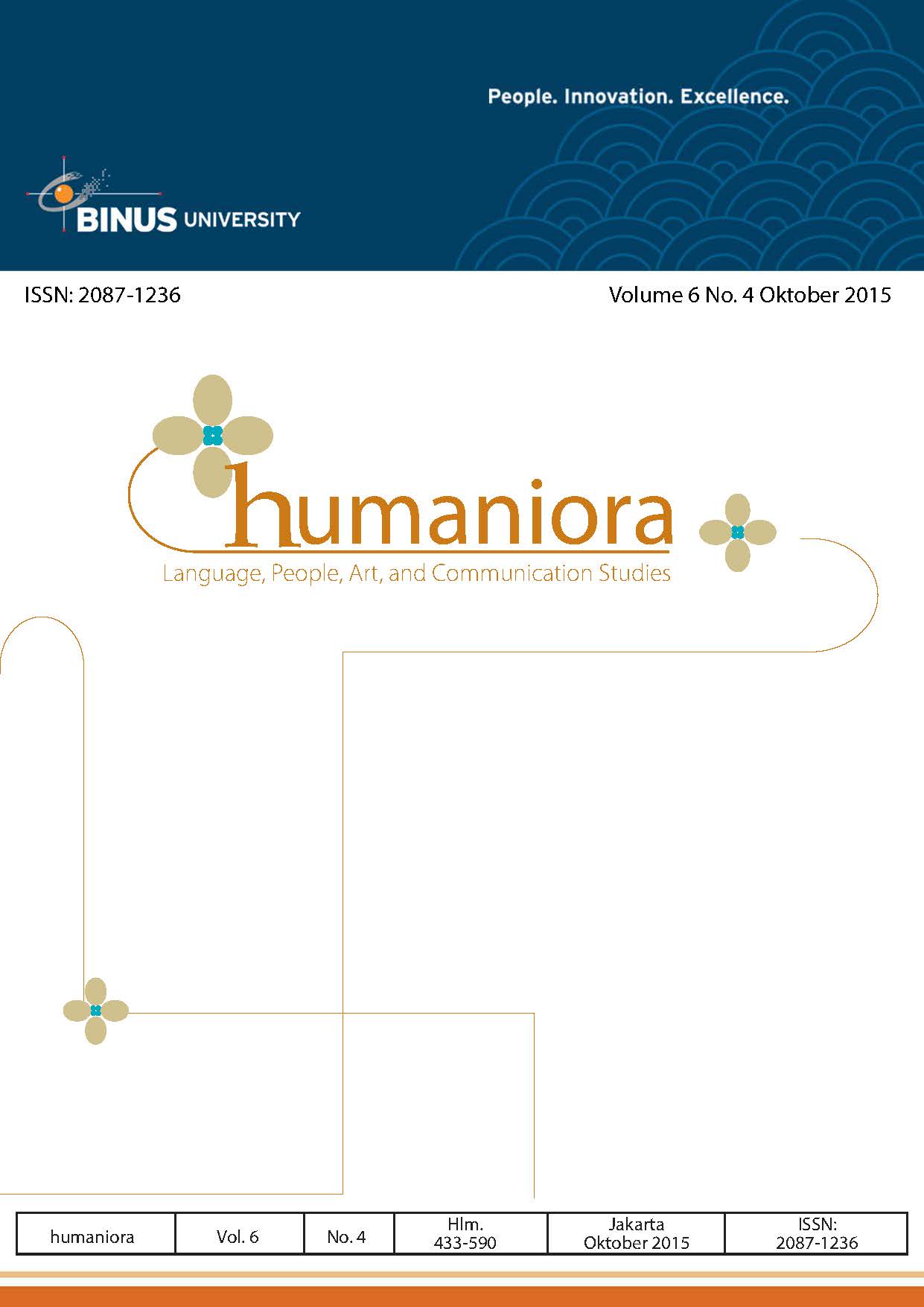Literasi Media Internet di Kalangan Mahasiswa
DOI:
https://doi.org/10.21512/humaniora.v6i4.3376Keywords:
university students, media, Internet, media literacyAbstract
This study aims to find out to what extent the Internet users in line with media literacy. According to Indonesia Internet Service Provider Association (APJII) and BPS Statistic Indonesia, it was found that Internet users in Indonesia have grown since three years ago up to 13% or become 71.19 million people until the end of 2013. According to research survey MarkPlus Insight, “netizen†or Internet users who spend more than three hours per day on Internet. Moreover, they are increasing from 24,2 Million people in 2012 and become 31,7 million people in 2013. This research used qualitative method by gathering the data through Focus Group Discussion (FGD) to private university students who spent for Internet 5 hours per day and less than 5 hours per day. The theory used in this research was media literacy. The result of this research stated that students who accessed the Internet below 5 hours per day were already busy with work and not too intense in using the Internet either via smartphone or a computer. Different findings came up from the students who accessed the Internet over 5 hours per day. Most of the time, they used the Internet for social media and instant messaging (instant messenger) through smartphones. Critical attitude towards the media message depends on the informants’ interest toward the information.
Â
References
Azzam, T. (2010). Peran strategi pers dalam memperkuat ketahanan nasional. Jurnal Ketahanan Nasional, 15(2), 33–47.
ASEAN Free Trade Area (AFTA). (n.d.). Pusat Kebijakan Pendapatan Negara – Badan Kebijakan Fiskal. Diakses dari http://www.tarif.depkeu.go.id/Others/?hi=AFTA
Brown, J. A. (1998). Media literacy perspectives. Journal of Communication, 48(1), 44–57.
Fantin, M. (2010). Perspectives on Media Literacy, Digital Literacy and Information Literacy. International Journal of Digital Literacy and Digital Competence, 1(4), 10–15. doi: 10.4018/jdldc.2010100102
Ferrington, G. (2006). What is media literacy? Diakses dari http://interact.uoregon.edu/mediaLit/mlr/readings/article s/whatisml.html
Grehenson, G. (2014). Menkominfo: 270 Juta Pengguna Ponsel di Indonesia. Diakses dari http://ugm.ac.id/id/berita/8776-menkominfo%3A.270.juta.pengguna.ponsel.di.indonesia
Hobbs, R. (1996). Media Literacy, Media Activism. Telemedium, the Journal of Media Literacy, 42(3).
Howe, N., & Strauss, W. (2000). Millennials rising: The next great generation. New York: Vintage Books.
Kellner, D., & Share, J. (2005). Toward critical media literacy: Core concepts, debates, organizations, and policy. Discourse: Studies in the Cultural Politics of Education, 26(3), 369–386. doi: 10.1080/01596300500200169
Kraidy, M. M. (2008). The Internet as a Mass Communication Medium. Journalism and Mass Communication, 2.
Marketeers. (2013). MarkPlus Insight: Pengguna Internet Indonesia 74 Juta di Tahun 2013. Diakses dari www.the-marketeers.com/archives/Indonesia%20Internet%20Users.html
Movementi, S. (2014a). Android Masih Rajai Pasar Ponsel Cerdas. Diakses dari http://www.tempo.co/read/news/2014/11/04/061619338/Android-Masih-Rajai-Pasar-Ponsel-Pintar
Movementi, S. (2014b). Facebook Masih Terfavorit di Indonesia. Diakses dari http://tekno.tempo.co/read/news/2014/09/22/072608871/facebook-masih-terfavorit-di-indonesia
Movementi, S. (2014c). Ponsel Pintar Pemula Paling Diminati. Diakses dari http://koran.tempo.co/konten/2014/11/28/358177/Ponsel-Pintar-Pemula-Paling-Diminati
Neuman, W. L. (2000). Social Research Methods, Qualitative and Quantitative Approaches (4th ed). USA: Allyn and Bacon.
Pitoyo, A. (2014). Jumlah Pengguna Internet Indonesia Capai 71, 19 Juta pada 2013. Diakses dari www.merdeka.com/teknologi/jumlah-pengguna-Internet-indonesia-capai-7119-juta-pada-2013.html
Potter, J.W. (2013). Media Literacy. New York: Sage.
Rahmi, A. (2013). Pengenalan literasi media pada anak usia sekolah dasar. SAWWA, 8(2), 261–275. Diakses dari http://journal.walisongo.ac.id/index.php/sww/article/view/116
Rubin, A. (1998). Media Literacy: Editor’s note. Journal of Communication, 48(1), 3–4.
Silverblatt, A. (2007). Media Literacy, Keys to Interpreting Media Messages. Westport: Praeger.
Singer, D. G., & Singer, J. L. (1998). Developing critical viewing skills and media literacy in children. The Annals of the American Academy of Political and Social Science, 557(1), 164–179. doi: 10.1177/0002716298557000013
Triyono, A. (2010). Pendidikan Literasi Media Pada Guru TK Gugus Kasunanan Sebagai Upaya Menanggulangi Dampak Negatif Televisi. Warta, 13(2), 150–159. Diakses dari https://publikasiilmiah.ums.ac.id/bitstream/handle/11617/1258/Agus%20Triyono.pdf?sequence=1&isAllowed=y
Downloads
Published
How to Cite
Issue
Section
License
Authors who publish with this journal agree to the following terms:
a. Authors retain copyright and grant the journal right of first publication with the work simultaneously licensed under a Creative Commons Attribution License - Share Alike that allows others to share the work with an acknowledgment of the work's authorship and initial publication in this journal.
b. Authors are able to enter into separate, additional contractual arrangements for the non-exclusive distribution of the journal's published version of the work (e.g., post it to an institutional repository or publish it in a book), with an acknowledgment of its initial publication in this journal.
c. Authors are permitted and encouraged to post their work online (e.g., in institutional repositories or on their website) prior to and during the submission process, as it can lead to productive exchanges, as well as earlier and greater citation of published work.
USER RIGHTS
All articles published Open Access will be immediately and permanently free for everyone to read and download. We are continuously working with our author communities to select the best choice of license options, currently being defined for this journal as follows: Creative Commons Attribution-Share Alike (CC BY-SA)




















